The Effect of Pore Volume on the Behavior of Polyurethane-Foam-Based Pressure Sensors
Abstract
:1. Introduction
2. Materials and Methods
2.1. Materials
2.2. CCVD Synthesis of Nitrogen-Doped, Bamboo-Shaped Carbon Nanotubes
2.3. Preparation of PU Samples
2.4. Preparation of the N-BCNT/PU Nanocomposite
2.5. Characterization Techniques
3. Results and Discussion
3.1. Characterization of the Synthesized N-BCNT
3.2. Electrical and Piezoresistive Properties of the Pressure Sensor
4. Conclusions
Author Contributions
Funding
Institutional Review Board Statement
Informed Consent Statement
Data Availability Statement
Acknowledgments
Conflicts of Interest
References
- Nabeel, M.; Varga, M.; Kuzsela, L.; Filep, Á.; Fiser, B.; Viskolcz, B.; Kollar, M.; Vanyorek, L. Preparation of Bamboo-like Carbon Nanotube Loaded Piezoresistive Polyurethane-Silicone Rubber Composite. Polymers 2021, 13, 2144. [Google Scholar] [CrossRef] [PubMed]
- Lee, J.; Kim, J.; Shin, Y.; Jung, I. Ultra-Robust Wide-Range Pressure Sensor with Fast Response Based on Polyurethane Foam Doubly Coated with Conformal Silicone Rubber and CNT/TPU Nanocomposites Islands. Compos. Part B Eng. 2019, 177, 107364. [Google Scholar] [CrossRef]
- Zhan, Z.; Lin, R.; Tran, V.-T.; An, J.; Wei, Y.; Du, H.; Tran, T.; Lu, W. Paper/Carbon Nanotube-Based Wearable Pressure Sensor for Physiological Signal Acquisition and Soft Robotic Skin. ACS Appl. Mater. Interfaces 2017, 9, 37921–37928. [Google Scholar] [CrossRef] [PubMed]
- Hong, S.Y.; Oh, J.H.; Park, H.; Yun, J.Y.; Jin, S.W.; Sun, L.; Zi, G.; Ha, J.S. Polyurethane Foam Coated with a Multi-Walled Carbon Nanotube/Polyaniline Nanocomposite for a Skin-like Stretchable Array of Multi-Functional Sensors. NPG Asia Mater. 2017, 9, e448. [Google Scholar] [CrossRef]
- Yin, Y.M.; Li, H.Y.; Xu, J.; Zhang, C.; Liang, F.; Li, X.; Jiang, Y.; Cao, J.W.; Feng, H.F.; Mao, J.N.; et al. Facile Fabrication of Flexible Pressure Sensor with Programmable Lattice Structure. ACS Appl. Mater. Interfaces 2021, 13, 10388–10396. [Google Scholar] [CrossRef]
- Huang, L.; Chen, J.; Xu, Y.; Hu, D.; Cui, X.; Shi, D.; Zhu, Y. Three-Dimensional Light-Weight Piezoresistive Sensors Based on Conductive Polyurethane Sponges Coated with Hybrid CNT/CB Nanoparticles. Appl. Surf. Sci. 2021, 548, 149268. [Google Scholar] [CrossRef]
- Zhao, T.; Li, T.; Chen, L.; Yuan, L.; Li, X.; Zhang, J. Highly Sensitive Flexible Piezoresistive Pressure Sensor Developed Using Biomimetically Textured Porous Materials. ACS Appl. Mater. Interfaces 2019, 11, 29466–29473. [Google Scholar] [CrossRef]
- Zhai, J.; Zhang, Y.; Cui, C.; Li, A.; Wang, W.; Guo, R.; Qin, W.; Ren, E.; Xiao, H.; Zhou, M. Flexible Waterborne Polyurethane/Cellulose Nanocrystal Composite Aerogels by Integrating Graphene and Carbon Nanotubes for a Highly Sensitive Pressure Sensor. ACS Sustain. Chem. Eng. 2021, 9, 14029–14039. [Google Scholar] [CrossRef]
- Choi, D.Y.; Kim, M.H.; Oh, Y.S.; Jung, S.-H.; Jung, J.H.; Sung, H.J.; Lee, H.W.; Lee, H.M. Highly Stretchable, Hysteresis-Free Ionic Liquid-Based Strain Sensor for Precise Human Motion Monitoring. ACS Appl. Mater. Interfaces 2017, 9, 1770–1780. [Google Scholar] [CrossRef]
- Cai, Y.; Shen, J.; Ge, G.; Zhang, Y.; Jin, W.; Huang, W.; Shao, J.; Yang, J.; Dong, X. Stretchable Ti3C2T x MXene/Carbon Nanotube Composite Based Strain Sensor with Ultrahigh Sensitivity and Tunable Sensing Range. ACS Nano 2018, 12, 56–62. [Google Scholar] [CrossRef]
- Ma, Z.; Wei, A.; Ma, J.; Shao, L.; Jiang, H.; Dong, D.; Ji, Z.; Wang, Q.; Kang, S. Lightweight, Compressible and Electrically Conductive Polyurethane Sponges Coated with Synergistic Multiwalled Carbon Nanotubes and Graphene for Piezoresistive Sensors. Nanoscale 2018, 10, 7116–7126. [Google Scholar] [CrossRef]
- Chun, S.; Son, W.; Choi, C. Flexible Pressure Sensors Using Highly-Oriented and Free-Standing Carbon Nanotube Sheets. Carbon N. Y. 2018, 139, 586–592. [Google Scholar] [CrossRef]
- Narongthong, J.; Das, A.; Le, H.H.; Wießner, S.; Sirisinha, C. An Efficient Highly Flexible Strain Sensor: Enhanced Electrical Conductivity, Piezoresistivity and Flexibility of a Strongly Piezoresistive Composite Based on Conductive Carbon Black and an Ionic Liquid. Compos. Part A Appl. Sci. Manuf. 2018, 113, 330–338. [Google Scholar] [CrossRef]
- Choi, W.; Lee, J.; Kyoung Yoo, Y.; Kang, S.; Kim, J.; Hoon Lee, J. Enhanced Sensitivity of Piezoelectric Pressure Sensor with Microstructured Polydimethylsiloxane Layer. Appl. Phys. Lett. 2014, 104, 123701. [Google Scholar] [CrossRef]
- Zhu, G.J.; Ren, P.G.; Wang, J.; Duan, Q.; Ren, F.; Xia, W.M.; Yan, D.X. A Highly Sensitive and Broad-Range Pressure Sensor Based on Polyurethane Mesodome Arrays Embedded with Silver Nanowires. ACS Appl. Mater. Interfaces 2020, 12, 19988–19999. [Google Scholar] [CrossRef]
- Ke, K.; Solouki Bonab, V.; Yuan, D.; Manas-Zloczower, I. Piezoresistive Thermoplastic Polyurethane Nanocomposites with Carbon Nanostructures. Carbon N. Y. 2018, 139, 52–58. [Google Scholar] [CrossRef]
- Feng, C.; Yi, Z.; Jin, X.; Seraji, S.M.; Dong, Y.; Kong, L.; Salim, N. Solvent Crystallization-Induced Porous Polyurethane/Graphene Composite Foams for Pressure Sensing. Compos. Part B Eng. 2020, 194, 108065. [Google Scholar] [CrossRef]
- Rinaldi, A.; Tamburrano, A.; Fortunato, M.; Sarto, M.S. A Flexible and Highly Sensitive Pressure Sensor Based on a PDMS Foam Coated with Graphene Nanoplatelets. Sensors 2016, 16, 2148. [Google Scholar] [CrossRef]
- Michel, T.R.; Capasso, M.J.; Cavusoglu, M.E.; Decker, J.; Zeppilli, D.; Zhu, C.; Bakrania, S.; Kadlowec, J.A.; Xue, W. Evaluation of Porous Polydimethylsiloxane/Carbon Nanotubes (PDMS/CNTs) Nanocomposites as Piezoresistive Sensor Materials. Microsyst. Technol. 2020, 26, 1101–1112. [Google Scholar] [CrossRef]
- Xu, D.; Zhang, H.; Pu, L.; Li, L. Fabrication of Poly (Vinylidene Fluoride)/Multiwalled Carbon Nanotube Nanocomposite Foam via Supercritical Fluid Carbon Dioxide: Synergistic Enhancement of Piezoelectric and Mechanical Properties. Compos. Sci. Technol. 2020, 192, 108108. [Google Scholar] [CrossRef]
- Li, X.P.; Li, Y.; Li, X.; Song, D.; Min, P.; Hu, C.; Zhang, H.-B.; Koratkar, N.; Yu, Z.Z. Highly Sensitive, Reliable and Flexible Piezoresistive Pressure Sensors Featuring Polyurethane Sponge Coated with MXene Sheets. J. Colloid Interface Sci. 2019, 542, 54–62. [Google Scholar] [CrossRef] [PubMed]
- Huang, W.; Dai, K.; Zhai, Y.; Liu, H.; Zhan, P.; Gao, J.; Zheng, G.; Liu, C.; Shen, C. Flexible and Lightweight Pressure Sensor Based on Carbon Nanotube/Thermoplastic Polyurethane-Aligned Conductive Foam with Superior Compressibility and Stability. ACS Appl. Mater. Interfaces 2017, 9, 42266–42277. [Google Scholar] [CrossRef] [PubMed]
- Yilgör, I.; Yilgör, E.; Wilkes, G.L. Critical Parameters in Designing Segmented Polyurethanes and Their Effect on Morphology and Properties: A Comprehensive Review. Polymer 2015, 58, A1–A36. [Google Scholar] [CrossRef]
- Solouki Bonab, V.; Manas-Zloczower, I. Revisiting Thermoplastic Polyurethane, from Composition to Morphology and Properties. J. Polym. Sci. Part B Polym. Phys. 2017, 55, 1553–1564. [Google Scholar] [CrossRef]
- Yang, W.; Dong, Q.; Liu, S.; Xie, H.; Liu, L.; Li, J. Recycling and Disposal Methods for Polyurethane Foam Wastes. Procedia Environ. Sci. 2012, 16, 167–175. [Google Scholar]
- Gurunathan, T.; Chung, J.S.; Nayak, S.K. Reactive Compatibilization of Biobased Polyurethane Prepolymer Toughening Polylactide Prepared by Melt Blending. J. Polym. Environ. 2016, 24, 287–297. [Google Scholar] [CrossRef]
- Gurunathan, T.; Nayak, S.K. The Influence of Reactive Organoclay on a Biorenewable Castor Oil-based Polyurethane Prepolymers Toughened Polylactide Nanocomposites. Polym. Adv. Technol. 2016, 27, 1484–1493. [Google Scholar] [CrossRef]
- Li, Z.; Li, B.; Chen, B.; Zhang, J.; Li, Y. 3D Printed Graphene/Polyurethane Wearable Pressure Sensor for Motion Fitness Monitoring. Nanotechnology 2021, 32, 395503. [Google Scholar] [CrossRef]
- Shen, J.; Guo, Y.; Zuo, S.; Shi, F.; Jiang, J.; Chu, J. Bioinspired Porous-Designed Hydrogel@ Polyurethane Sponge Piezoresistive Sensor for Human–Machine Interfacing. Nanoscale 2021, 13, 19155–19164. [Google Scholar] [CrossRef]
- Jain, P.; Pradeep, T. Potential of Silver Nanoparticle-coated Polyurethane Foam as an Antibacterial Water Filter. Biotechnol. Bioeng. 2005, 90, 59–63. [Google Scholar] [CrossRef]
- Mester, E.; Pecsmány, D.; Jálics, K.; Filep, Á.; Varga, M.; Gráczer, K.; Viskolcz, B.; Fiser, B. Exploring the Potential to Repurpose Flexible Moulded Polyurethane Foams as Acoustic Insulators. Polymers 2021, 14, 163. [Google Scholar] [CrossRef]
- American Chemical Society. Polyurethane Chemistry: Renewable Polyols and Isocyanates; ACS Publications: Washington, DC, USA, 2021; ISBN 0841298408. [Google Scholar]
- Zhuang, Z.; Cheng, N.; Zhang, L.; Liu, L.; Zhao, J.; Yu, H. Wearable Strain Sensor Based on Highly Conductive Carbon Nanotube/Polyurethane Composite Fibers. Nanotechnology 2020, 31, 205701. [Google Scholar] [CrossRef]
- Jiang, L.; Hong, H.; Hu, J. Facile Thermoplastic Polyurethane-Based Multi-Walled Carbon Nanotube Ink for Fabrication of Screen-Printed Fabric Electrodes of Wearable e-Textiles with High Adhesion and Resistance Stability under Large Deformation. Text. Res. J. 2021, 91, 2487–2499. [Google Scholar] [CrossRef]
- Kim, S.; Amjadi, M.; Lee, T.-I.; Jeong, Y.; Kwon, D.; Kim, M.S.; Kim, K.; Kim, T.-S.; Oh, Y.S.; Park, I. Wearable, Ultrawide-Range, and Bending-Insensitive Pressure Sensor Based on Carbon Nanotube Network-Coated Porous Elastomer Sponges for Human Interface and Healthcare Devices. ACS Appl. Mater. Interfaces 2019, 11, 23639–23648. [Google Scholar] [CrossRef]
- Cho, H.; Lee, H.; Lee, S.; Kim, S. Reduced Graphene Oxide-Based Wearable and Bio-Electrolyte Triggered Pressure Sensor with Tunable Sensitivity. Ceram. Int. 2021, 47, 17702–17710. [Google Scholar] [CrossRef]
- Liang, Z.; Zhang, H.; Huang, R.; Xu, T.; Fong, H. Superhydrophobic and Elastic 3D Conductive Sponge Made from Electrospun Nanofibers and Reduced Graphene Oxide for Sweatproof Wearable Tactile Pressure Sensor. Polymer 2021, 230, 124025. [Google Scholar] [CrossRef]
- Wang, X.; Liu, X.; Schubert, D.W. Highly Sensitive Ultrathin Flexible Thermoplastic Polyurethane/Carbon Black Fibrous Film Strain Sensor with Adjustable Scaffold Networks. Nano Micro Lett. 2021, 13, 1–19. [Google Scholar] [CrossRef]
- Bertolini, M.C.; Dul, S.; Lopes Pereira, E.C.; Soares, B.G.; Barra, G.M.O.; Pegoretti, A. Fabrication and Characterization of Piezoresistive Flexible Pressure Sensors Based on Poly (Vinylidene Fluoride)/Thermoplastic Polyurethane Filled with Carbon Black-polypyrrole. Polym. Compos. 2021, 42, 6621–6634. [Google Scholar] [CrossRef]
- Ji, C.; Zhang, Q.; Jing, Z.; Liu, Y.; Han, D.; Wang, J.; Zhang, W.; Sang, S. Highly Sensitive Wearable Flexible Pressure Sensor Based on Conductive Carbon Black/Sponge. IEEE Trans. Electron Devices 2021, 68, 5198–5203. [Google Scholar] [CrossRef]
- Song, P.; Song, J.; Zhang, Y. Stretchable Conductor Based on Carbon Nanotube/Carbon Black Silicone Rubber Nanocomposites with Highly Mechanical, Electrical Properties and Strain Sensitivity. Compos. Part B Eng. 2020, 191, 107979. [Google Scholar] [CrossRef]
- Tran, M.T.; Tung, T.T.; Sachan, A.; Losic, D.; Castro, M.; Feller, J.F. 3D Sprayed Polyurethane Functionalized Graphene / Carbon Nanotubes Hybrid Architectures to Enhance the Piezo-Resistive Response of Quantum Resistive Pressure Sensors. Carbon N. Y. 2020, 168, 564–579. [Google Scholar] [CrossRef]
- Tewari, A.; Gandla, S.; Bohm, S.; McNeill, C.R.; Gupta, D. Highly Exfoliated MWNT-RGO Ink-Wrapped Polyurethane Foam for Piezoresistive Pressure Sensor Applications. ACS Appl. Mater. Interfaces 2018, 10, 5185–5195. [Google Scholar] [CrossRef] [PubMed]
- Wang, C.; Murugadoss, V.; Kong, J.; He, Z.; Mai, X.; Shao, Q.; Chen, Y.; Guo, L.; Liu, C.; Angaiah, S.; et al. Overview of Carbon Nanostructures and Nanocomposites for Electromagnetic Wave Shielding. Carbon N. Y. 2018, 140, 696–733. [Google Scholar] [CrossRef]
- Lv, B.; Chen, X.; Liu, C. A Highly Sensitive Piezoresistive Pressure Sensor Based on Graphene Oxide/Polypyrrole@polyurethane Sponge. Sensors 2020, 20, 1219. [Google Scholar] [CrossRef]
- Terrones, M.; Grobert, N.; Terrones, H. Synthetic Routes to Nanoscale BxCyNz Architectures. Carbon N. Y. 2002, 40, 1665–1684. [Google Scholar] [CrossRef]
- Sung, G.; Kim, S.K.; Kim, J.W.; Kim, J.H. Effect of Isocyanate Molecular Structures in Fabricating Flexible Polyurethane Foams on Sound Absorption Behavior. Polym. Test. 2016, 53, 156–164. [Google Scholar] [CrossRef]
- Oppon, C.; Hackney, P.M.; Shyha, I.; Birkett, M. Effect of Varying Mixing Ratios and Pre-Heat Temperature on the Mechanical Properties of Polyurethane (PU) Foam. Procedia Eng. 2015, 132, 701–708. [Google Scholar] [CrossRef]
- Lee, D.H.; Lee, W.J.; Kim, S.O. Highly Efficient Vertical Growth of Wall-Number-Selected, N-Doped Carbon Nanotube Arrays. Nano Lett. 2009, 9, 1427–1432. [Google Scholar] [CrossRef]
- Wiggins-Camacho, J.D.; Stevenson, K.J. Effect of Nitrogen Concentration on Capacitance, Density of States, Electronic Conductivity, and Morphology of N-Doped Carbon Nanotube Electrodes. J. Phys. Chem. C 2009, 113, 19082–19090. [Google Scholar] [CrossRef]
- Berciaud, S.; Ryu, S.; Brus, L.E.; Heinz, T.F. Probing the Intrinsic Properties of Exfoliated Graphene: Raman Spectroscopy of Free-Standing Monolayers. Nano Lett. 2009, 9, 346–352. [Google Scholar] [CrossRef]
- Ouellet, S.; Cronin, D.; Worswick, M. Compressive Response of Polymeric Foams under Quasi-Static, Medium and High Strain Rate Conditions. Polym. Test. 2006, 25, 731–743. [Google Scholar] [CrossRef]
- Dupuis, R.; Aubry, E. Development and Comparison of Foam Comprehensive Law in Great Deformation. In Proceedings of the XIth International Congress and Exposition, Orlando, FL, USA, 2 – 5 June 2008; pp. 2–5. [Google Scholar]
- Wang, T.; Li, J.; Zhang, Y.; Liu, F.; Zhang, B.; Wang, Y.; Jiang, R.; Zhang, G.; Sun, R.; Wong, C. Highly Ordered 3D Porous Graphene Sponge for Wearable Piezoresistive Pressure Sensor Applications. Chem. Eur. J. 2019, 25, 6378–6384. [Google Scholar] [CrossRef]
- Zhong, W.; Ding, X.; Li, W.; Shen, C.; Yadav, A.; Chen, Y.; Bao, M.; Jiang, H.; Wang, D. Facile Fabrication of Conductive Graphene/Polyurethane Foam Composite and Its Application on Flexible Piezo-Resistive Sensors. Polymers 2019, 11, 1289. [Google Scholar] [CrossRef] [Green Version]
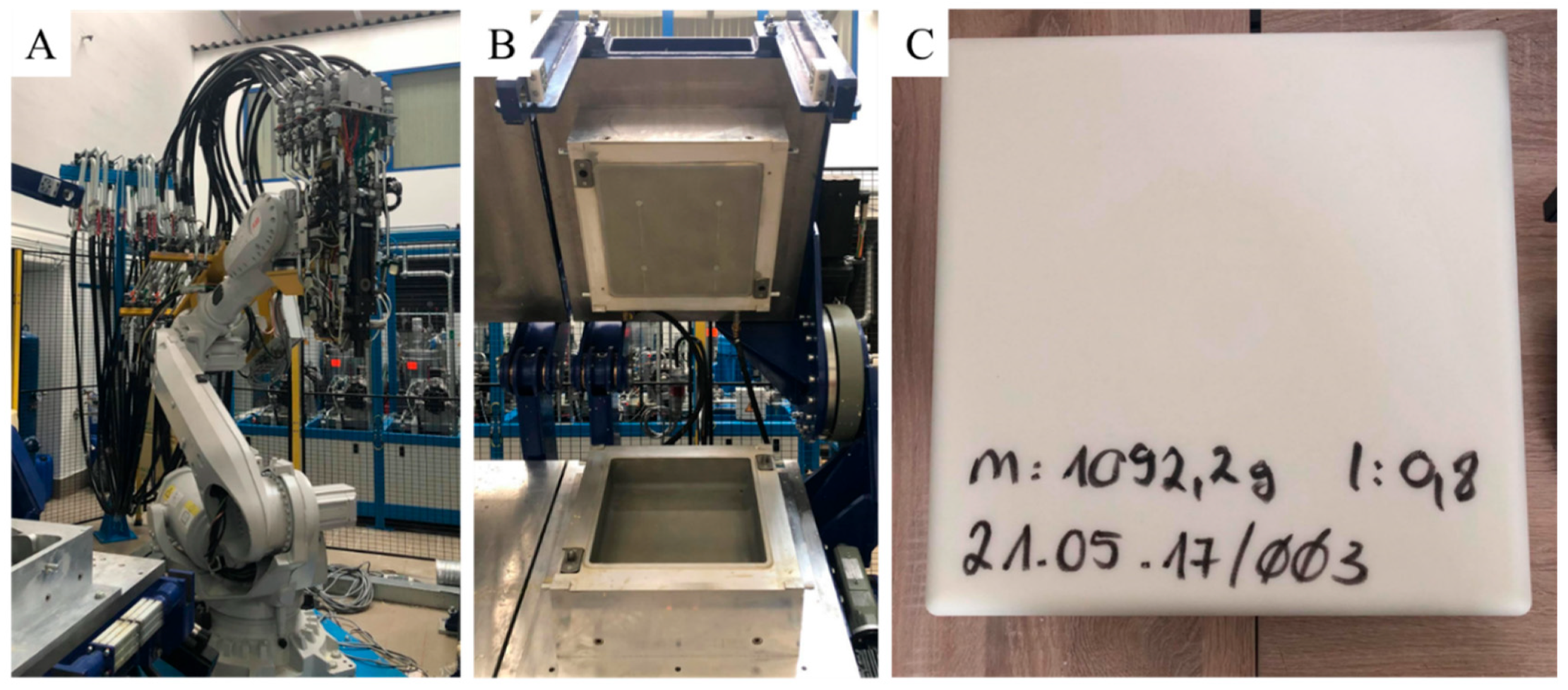
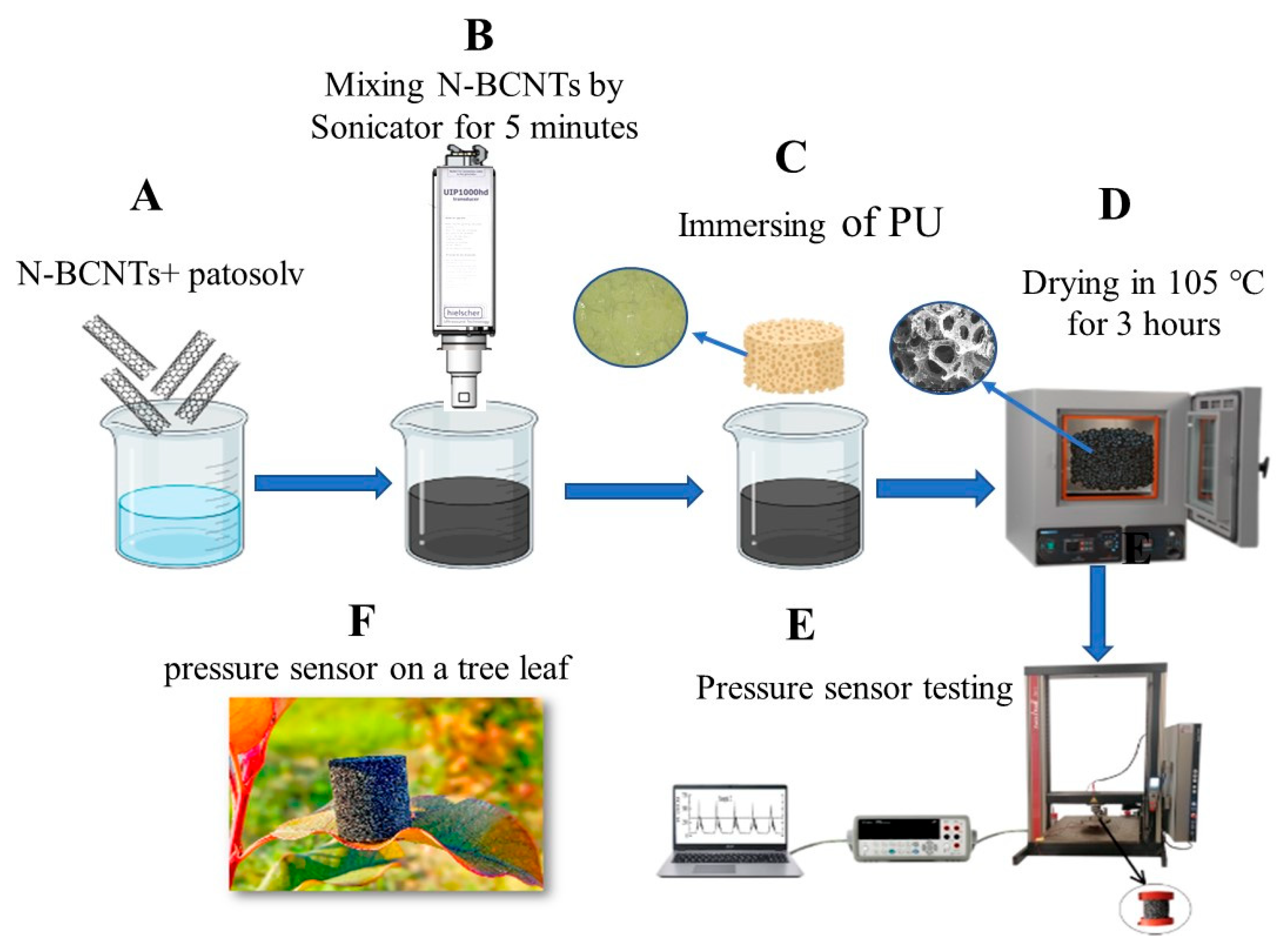


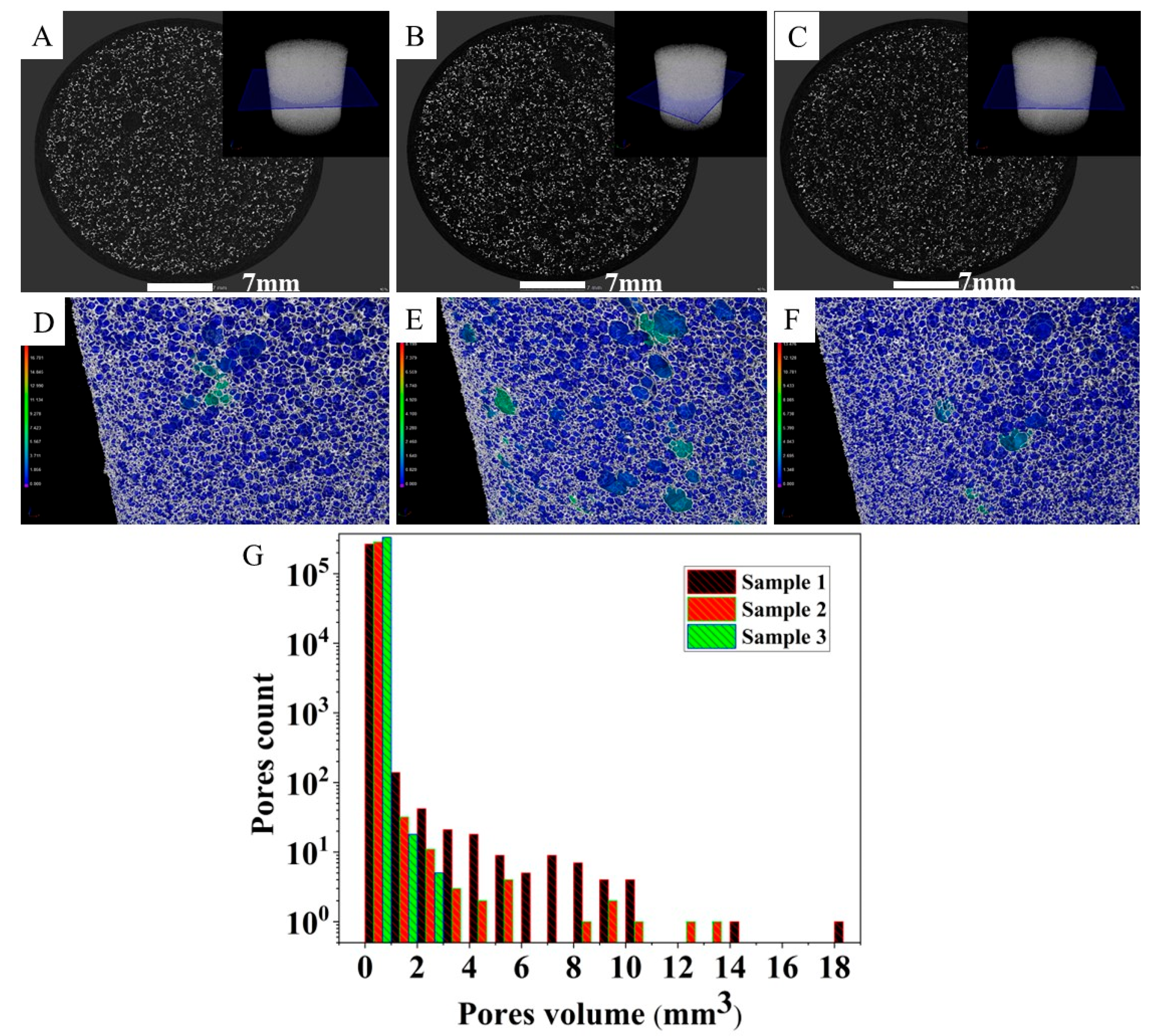
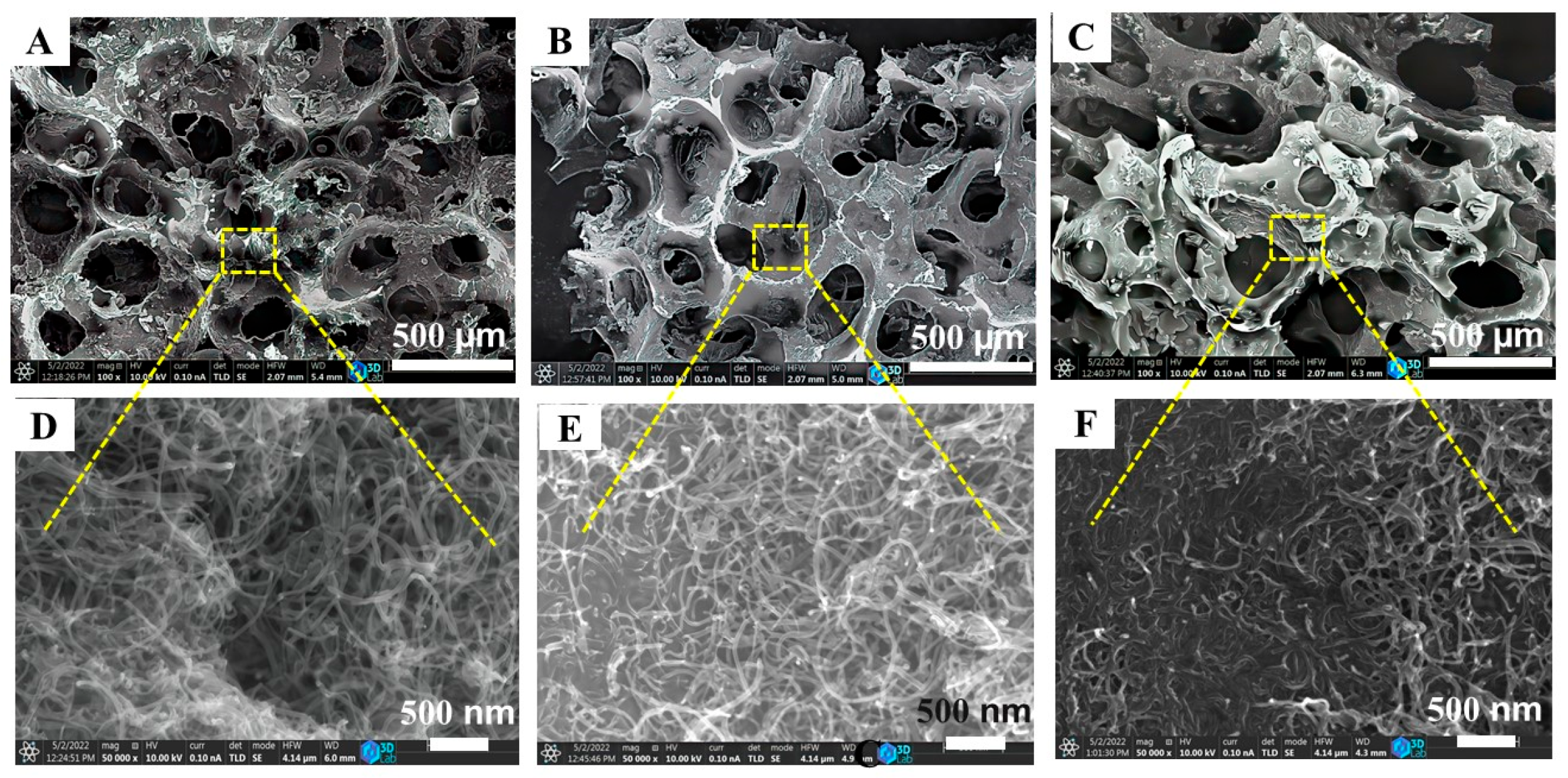
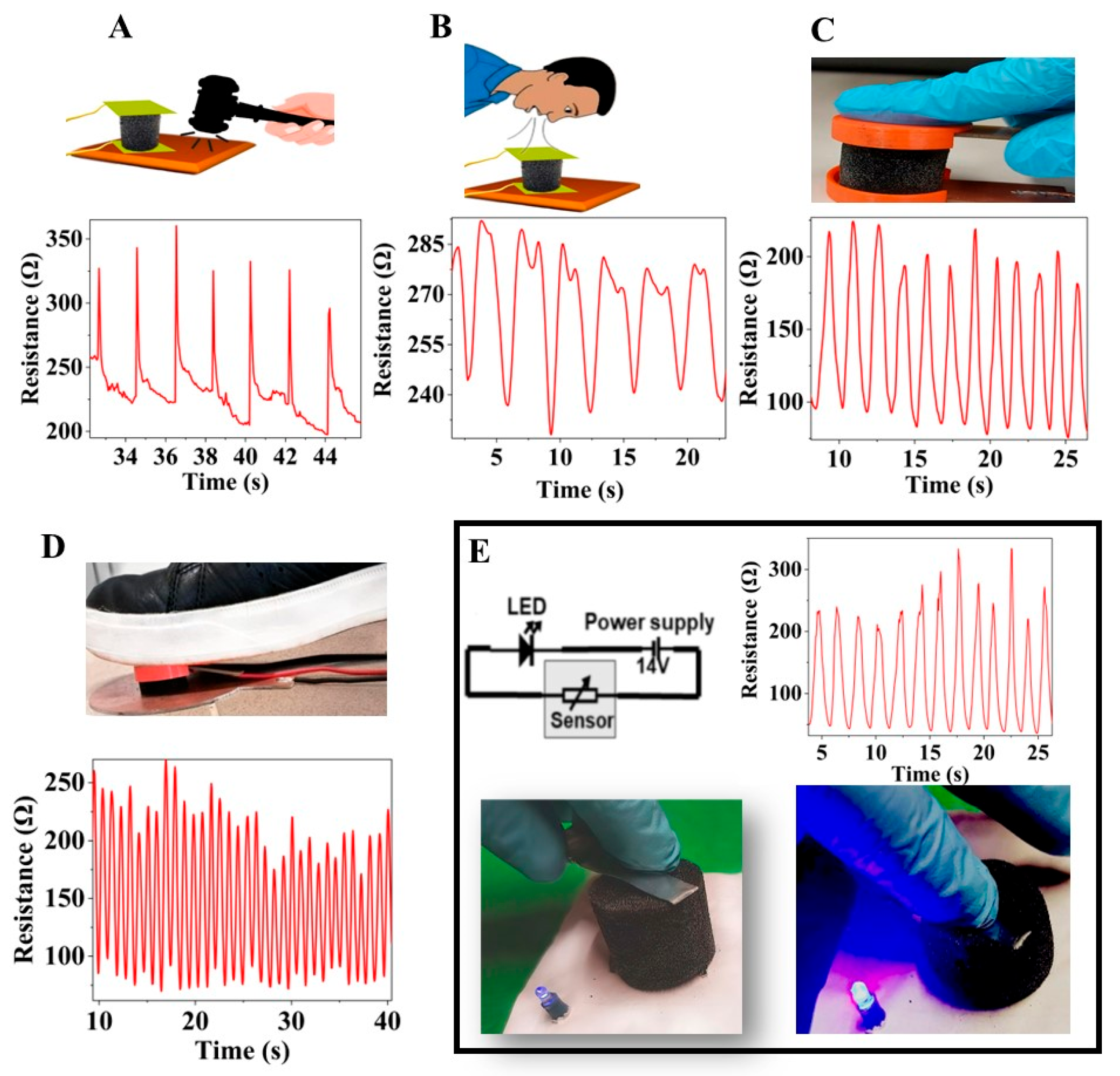
| Polyol: Isocyanate Ratio | N-BCNT Weight | PU Weight | N-BCNT wt.% | |
|---|---|---|---|---|
| Sample 1 | 1.0:0.8 | 0.146 g | 1.46 g | 10% |
| Sample 2 | 1.0:1.0 | 0.147 g | 1.47 g | 10% |
| Sample 3 | 1.0:1.1 | 0.141 g | 1.41 g | 10% |
| Samples | S in Pressure Range 0–3 kPa−1 | S in Pressure Range 6–15 kPa−1 | S in Pressure Range 16–30 kPa−1 | GF in Strain Range (0.00–0.08) | GF in Strain Range (0.18–0.27) | GF in Strain Range (0.27–0.57) |
|---|---|---|---|---|---|---|
| Sample 1 | 0.12 kPa−1 | 0.05 kPa−1 | 0.008 kPa−1 | 3.17 | 2.87 | 0.58 |
| Sample 2 | 0.08 kPa−1 | 0.04 kPa−1 | 0.017 kPa−1 | 1.68 | 3.91 | 1.09 |
| Sample 3 | 0.02 kPa−1 | 0.09 kPa−1 | 0.019 kPa−1 | 0.75 | 4.58 | 1.27 |
Publisher’s Note: MDPI stays neutral with regard to jurisdictional claims in published maps and institutional affiliations. |
© 2022 by the authors. Licensee MDPI, Basel, Switzerland. This article is an open access article distributed under the terms and conditions of the Creative Commons Attribution (CC BY) license (https://creativecommons.org/licenses/by/4.0/).
Share and Cite
Nabeel, M.; Varga, M.; Kuzsella, L.; Fiser, B.; Vanyorek, L.; Viskolcz, B. The Effect of Pore Volume on the Behavior of Polyurethane-Foam-Based Pressure Sensors. Polymers 2022, 14, 3652. https://doi.org/10.3390/polym14173652
Nabeel M, Varga M, Kuzsella L, Fiser B, Vanyorek L, Viskolcz B. The Effect of Pore Volume on the Behavior of Polyurethane-Foam-Based Pressure Sensors. Polymers. 2022; 14(17):3652. https://doi.org/10.3390/polym14173652
Chicago/Turabian StyleNabeel, Mohammed, Miklós Varga, László Kuzsella, Béla Fiser, László Vanyorek, and Béla Viskolcz. 2022. "The Effect of Pore Volume on the Behavior of Polyurethane-Foam-Based Pressure Sensors" Polymers 14, no. 17: 3652. https://doi.org/10.3390/polym14173652
APA StyleNabeel, M., Varga, M., Kuzsella, L., Fiser, B., Vanyorek, L., & Viskolcz, B. (2022). The Effect of Pore Volume on the Behavior of Polyurethane-Foam-Based Pressure Sensors. Polymers, 14(17), 3652. https://doi.org/10.3390/polym14173652







